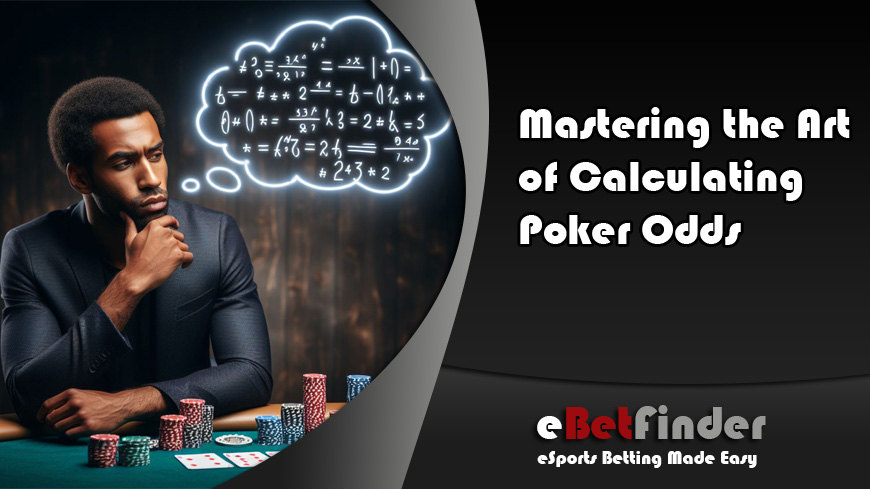
In the exhilarating world of poker, success often hinges on one’s ability to make informed decisions based on probability and mathematics. At the heart of this strategic endeavor lies the art of calculating poker odds—a skill that separates the novices from the masters.
Whether you’re facing a crucial decision on the river or contemplating a risky bluff, understanding the intricacies of poker odds can significantly enhance your chances of success at the table.
Understanding Poker Odds
At its core, poker is a game of incomplete information, where players must make decisions based on the information available to them at any given moment. Poker odds refer to the probability of a certain event occurring, such as completing a hand or hitting a specific card on the turn or river. By calculating these odds, players can assess the potential risks and rewards of their actions and make more informed decisions accordingly.
Calculating Pot Odds
One of the fundamental concepts in poker odds calculation is pot odds, which refers to the ratio of the current size of the pot to the size of the bet you are considering making. To calculate pot odds, simply divide the size of the pot by the size of the bet.
For example, if the pot contains $100 and your opponent bets $20, the pot odds are 100:20, or 5:1. This means that you would need to win at least 1 out of every 5 times to break even on your call.
Using Outs to Calculate Hand Odds
In addition to pot odds, players can also calculate hand odds by determining the number of outs—the cards that can improve their hand—remaining in the deck. By counting the number of outs and comparing them to the number of unseen cards, players can estimate the probability of completing their hand by the river.
For example, if you have an open-ended straight draw with 8 outs, there are 47 unseen cards remaining in the deck (52 cards in total, minus the 2 in your hand and the 3 on the flop). Therefore, the probability of hitting your straight on the turn or river is approximately 17% (8 divided by 47).
Technology and Specialized Apps
In today’s digital age, technology and specialized apps have revolutionized the way players approach poker, offering invaluable tools to aid players in making informed decisions at the table.
An online poker odds calculator stands as a prime example of this technological advancement. This provides players with real-time insights into the probability of winning a particular hand based on various factors such as their cards, the table’s community cards, and their opponent’s hand.
With the best online poker odds calculator, accuracy is guaranteed to the decimal point, empowering players to make calculated decisions with confidence. By integrating this innovative tool into their arsenal, players can cultivate a more analytical mindset and refine their strategic approach to the game.
Through practice and familiarity with the online poker odds calculator, players gain a deeper understanding of how different variables—such as opponent range, bet sizes, and community cards—affect the odds of success.
Putting It All Together
Once armed with calculated pot odds and hand odds, poker players further refine their decision-making process by evaluating the expected value (EV) of their choices. EV serves as a cornerstone in strategic poker play, offering insight into the long-term profitability of a particular decision.
By multiplying the probability of winning a hand by the potential profit gained and subtracting the probability of losing by the potential loss incurred, players arrive at the EV of their decision.
A positive EV signifies that a decision is likely to yield a profit over time, indicating a favorable move. Conversely, a negative EV suggests that the decision is unprofitable in the long run, prompting players to reconsider their course of action. This mathematical concept empowers players to make calculated risks and strategic moves that maximize their profitability and edge over opponents.
Integration of EV analysis into poker strategy not only enhances decision-making proficiency but also cultivates a deeper understanding of the game’s dynamics. By consistently assessing the EV of various decisions, players develop a more nuanced approach to poker, grounded in mathematical principles and probability theory.
Over time, this analytical mindset becomes ingrained, allowing players to navigate complex situations with confidence and precision. Whether faced with a critical decision on the river or contemplating a strategic bluff, the ability to calculate EV optimizes a player’s chances of success.
Tips for Improving Your Odds Calculation Skills
While mastering the art of calculating poker odds requires practice and experience, there are several strategies you can employ to sharpen your skills:
- Familiarize yourself with basic probability concepts and mathematical principles.
- Use online poker tools and resources to streamline the calculation process and gain insights into optimal decision-making.
- Review hand histories and analyze past decisions to identify areas for improvement and refine your strategy.
- Practice mental arithmetic and quick calculations to expedite the decision-making process during live play.
- Continuously seek feedback from experienced players and professionals to deepen your understanding of poker odds and refine your approach.
Conclusion
In the ever-evolving landscape of poker, the ability to calculate odds accurately and efficiently is a hallmark of strategic excellence. By mastering the fundamentals of poker odds calculation and honing your decision-making skills, you can gain a competitive edge at the table and maximize your chances of success.
Whether you’re a seasoned veteran or a budding enthusiast, embracing the art of calculating poker odds is essential for navigating the complexities of the game and achieving mastery in the pursuit of victory.
